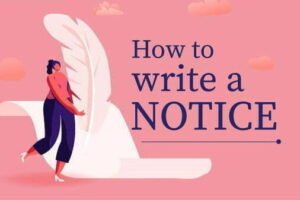
Best Paragraph Writing : Structure, Types & Samples
Paragraph Writing Notes for Class 7th English

Introduction to Paragraph Writing
Paragraph Writing
A paragraph is a group of sentences that talk about one main idea. It is like a small story or a piece of writing that makes sense on its own. In English, writing good paragraphs is an important skill because it helps us share our thoughts clearly. Whether you are writing a letter, a story, or an essay, paragraphs make your writing easy to read and understand.
Imagine you are telling your friend about your favorite game. If you keep jumping from one idea to another without a break, your friend might get confused. A paragraph keeps everything organized by focusing on one topic at a time. For example, one paragraph could describe the rules of the game, and another could explain why you like it.
What Makes a Paragraph?
A good paragraph has three main parts:
- Topic Sentence: This is the first sentence of the paragraph. It tells the reader what the paragraph is about. For example, “My favorite season is winter because it brings snow and fun activities.”
- Supporting Sentences: These sentences give more details about the topic. They explain, describe, or give examples. For instance, “In winter, I love building snowmen with my friends and drinking hot chocolate by the fire.”
- Concluding Sentence: This is the last sentence. It sums up the paragraph or gives a final thought. For example, “That’s why winter feels so special to me every year.”
Every sentence in a paragraph should connect to the main idea. If you start talking about something else, like summer vacations, it doesn’t belong in that paragraph.
Features of a Good Paragraph
A paragraph is not just a bunch of sentences thrown together. It needs to have these qualities:
- Unity: All sentences should focus on one idea. Don’t mix unrelated thoughts.
- Coherence: The sentences should flow smoothly. Use words like “because,” “also,” “then,” or “however” to connect ideas.
- Clarity: Write in a way that’s easy to understand. Avoid confusing or very long sentences.
- Length: A paragraph is usually 5-7 sentences long, but it can be shorter or longer depending on the topic. For Class 7, aim for 80-100 words per paragraph.
Types of Paragraphs :
There are different kinds of paragraphs depending on what you want to say. Here are four main types:
- Descriptive Paragraph: This type describes something, like a person, place, or thing. It uses words that appeal to the senses (sight, sound, smell, touch, taste). Example: “The garden was full of bright red roses, their sweet smell filling the air.”
- Narrative Paragraph: This tells a story or an event. It has a beginning, middle, and end. Example: “Last Sunday, I went to the park, played with my dog, and then ate ice cream.”
- Expository Paragraph: This explains something or gives information. Example: “Rain is important because it helps plants grow and fills rivers with water.”
- Persuasive Paragraph: This tries to convince the reader about something. Example: “Everyone should recycle because it saves trees and keeps our planet clean.”
In Class 7, you might be asked to write any of these types, so practice them all!
Steps to Write a Paragraph
Writing a paragraph is easy if you follow these steps:
- Choose a Topic: Pick one idea to write about, like “My Best Friend” or “A Rainy Day.”
- Plan Your Ideas: Think of 3-4 points about the topic. For “My Best Friend,” you could write about their name, why they’re special, and something fun you did together.
- Write the Topic Sentence: Start with a clear sentence that tells the main idea.
- Add Supporting Details: Write 3-5 sentences with examples or explanations.
- End with a Conclusion: Finish with a sentence that wraps up your thoughts.
- Check Your Work: Read it again to fix spelling, grammar, or unclear parts.
Example Paragraph Writing
Topic: My Favorite Hobby
“My favorite hobby is reading books because it takes me to new worlds. Every evening, I sit by my window with a storybook and imagine I’m a character in it. Last week, I read a book about pirates and felt like I was sailing the sea with them. Reading also helps me learn new words and ideas. Sometimes, I share the stories with my friends, and we talk about them for hours. That’s why reading is not just fun but also makes me smarter.”
Tips for Better Paragraph Writing
Here are some simple tips to make your paragraphs shine:
- Use Simple Words: Don’t try to use big words you don’t understand. Clear and simple is best.
- Add Examples: Examples make your writing interesting. If you say you like rain, tell why—like splashing in puddles.
- Vary Sentences: Don’t start every sentence the same way. Mix short and long sentences.
- Stay on Topic: If your paragraph is about a pet, don’t start writing about school.
- Practice Writing: The more you write, the better you get. Try writing one paragraph every day.
Common Mistakes to Avoid
- No Topic Sentence: Without it, the reader won’t know what you’re talking about.
- Too Many Ideas: Stick to one topic per paragraph.
- Choppy Sentences: Don’t write like this: “I like dogs. They bark. They run.” Instead, connect ideas: “I like dogs because they bark happily and run around with energy.”
- Spelling Errors: Mistakes like “freind” instead of “friend” can confuse readers.
Practice Exercise: Paragraph Writing
Try writing a paragraph on these topics:
- “A Visit to the Zoo”
- “Why I Love My School”
- “The Best Day of My Life”
For example:
A Visit to the Zoo
“Last month, I visited the zoo with my family, and it was an exciting day. First, we saw the lions roaring loudly in their cages, which made my little brother jump. Then, we watched the monkeys swinging from branch to branch, making funny faces at us. The colorful parrots were my favorite because they squawked hello in their bright feathers. We even fed some deer, and their soft noses tickled my hand. It was a day full of fun and learning about animals.”
Why Paragraph Writing Matters
Learning to write paragraphs is a big step in English. It helps you in exams, essays, and even when you write emails later in life. Good paragraphs show that you can think clearly and share your ideas with others. Plus, it’s fun to see your thoughts come alive on paper!
Conclusion
Paragraph writing is like building a small house of words. The topic sentence is the door, the supporting sentences are the walls, and the concluding sentence is the roof. With practice, you can write paragraphs that are strong, clear, and interesting. So grab a pen, pick a topic, and start writing today!
Download pdf notes and Sulutions of the Chapter:



